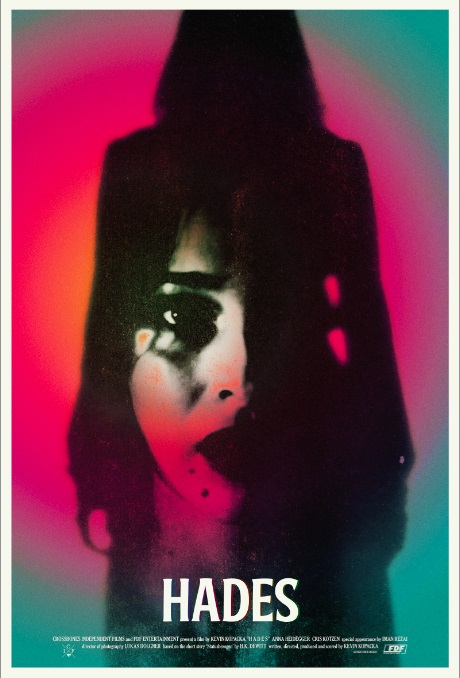
Austrian filmmaker and artist Kevin Kopacka wrote, directed and edited the 15-minute HADES in 2015. It's based on the original short story "Statusbezogen" by H K Dewitt (who also co-produces here).
Ostensibly, the plot concerns M (Anna Heidegger) and her failed relationship with Schweitzer (Cris Kotzen). The affair is reflected upon by M through a recurring dream in which she must cross each of the five rivers of Hades - each one appearing to represent a different stage in their relationship.
To this latter end, the film is captioned occasionally, chapter-style, with titles such as "Lamentation", "Sorrow" and "Styx" - each of which is accompanied by onscreen text recalling key lines of dialogue spoken in the past: "When will I see you again?" (asked after their first night together, having met at a party), "Won't you come in and join me?" and so on.
We see M and Schweitzer in happier times, taking selfies together, having sex etc. But there is also a sense of loss and longing evident from the opening moments onwards. M searches for her lover through empty corridors and struggles to discover what lies behind locked doors. A shower-based incident implies a tragic end came to their relationship ... but what exactly happened is deliberately obscured for the most part, as M's recurring dream keeps her searching for answers.
There is no dialogue in this Berlin-based production. Rather, the film is very much carried along by its rich visuals and hugely impressive sound design. The use of colour-filtered lighting, working in conjunction with highly considered camerawork and editing, brings to mind Dario Argento's SUSPIRIA: all garish primary colours and meticulous, dreamlike framing.
Elements of gialli are obvious throughout, from the mysterious nature of the plot to its hyper-stylised delivery. Indeed, it's also easy to draw comparisons with the giallo-worshipping cinema of Bruno Forzani and Helene Cattet (AMER, THE STRANGE COLOUR OF YOUR BODY'S TEARS). HADES also shares the Belgian filmmakers' love of non-linear plotting and abstract imagery.
Which is where HADES cunningly deviates from simply being an ode to Italian horror films of the 1970s. If anything, its style is arthouse: the unconventional narrative, the emphasis on mood and aesthetics over overt storytelling, the silent cinema-style expressionism evidenced throughout.
There's also a great sense of sound design at play here. Memories which are conveyed through audio - running water, muffled shouts, ominous funereal music - all of which is highly effective when married to the beautiful, nightmarish visuals.
And ... how many short films do you know that can make Phil Spector's pop classic "Be My Baby" (as sung here by Kopacka) sound so haunting?!
Shot mainly on digital in a 1.66:1 aspect ratio, the flashback sequences have that added draw of having been filmed in Super 8mm. Kudos to cinematographer Lukas Dolgener for capturing everything so sublimely across both formats.
Performances are strong in that both leads are well-suited physically to their roles and express great emotions - Kotzen distance towards his lover as the relationship dissolves is palpable; Heidegger's increasing anxieties come across expertly as she edges ever closer to realising her own personal Hell.
The real star of the show though is Kopacka, who packs a lot of film knowledge into quarter of an hour - echoes of David Lynch, F W Murneau, Stanley Kubrick and of course Argento abound. Perhaps unsurprisingly, given that he's an adept painter and a graduate of Berlin's University of Fine Arts, HADES emerges as a beguiling work of art.
We were sent the film to review via an online link. I'm unaware of any release (though it has been screened on the festival front). If you get the chance to watch this curious beast, either at a fest or if it does crop up on some DVD compilation of short films, then I highly recommend doing so.
In the meantime, I await Kopacka's future cinematic endeavours with great interest.
Review by Stuart Willis
| Written & Directed by Kevin Kopacka |